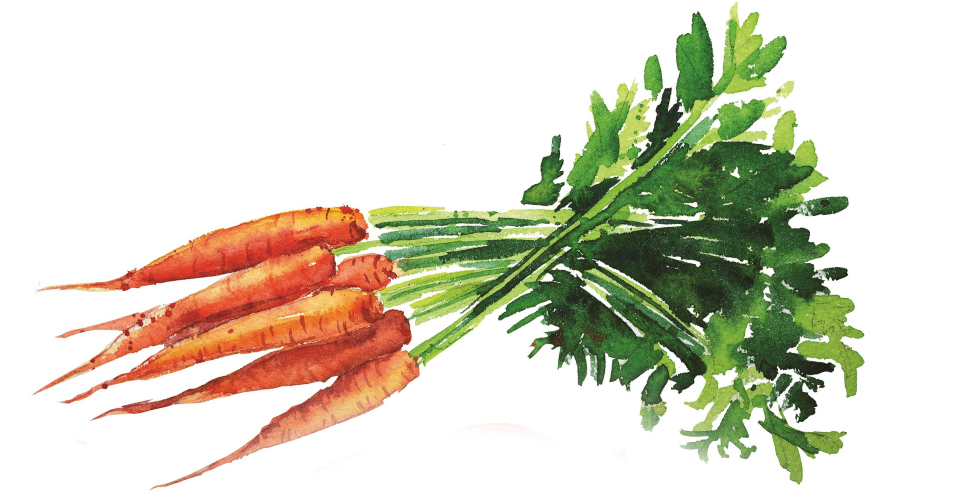By Mary Bergin
FROM PLANT TO PLATE
When picked at the peak of ripeness, fruits and vegetables taste outstanding all on their own, with little need for complicated preparations. Snack on raw sugar snap peas, including the edible pod, or bite into a tomato as though it were an apple. The simple roasting of carrots or squash works. So does the quick steaming of string beans, or sautéeing of Brussels sprouts.
But locally-grown ingredients also motivate chefs to go above and beyond traditional recipes, sometimes turning these ingredients into menu stars— especially in Madison.
At Harvest, a multi-course and fixed-price asparagus dinner will be served on May 20. Last year’s menu featured deviled eggs with asparagus pesto, asparagus-pork paté, chilled asparagus soup, asparagus risotto, asparagus crab cakes and a dessert of asparagus panna cotta. This year’s menu will be released closer to the date.
In August, heirloom tomatoes are the star of the show for another special dinner. Last year’s guests tried heirloom tartare with whipped goat cheese and grilled focaccia bread and other courses featured the stuffed, smoked or pulverized ripened fruit. All dishes stay true to the restaurant’s commitment to create an evolving menu “that focuses on the seasonality and locality of the products, rather than any one specific cuisine.”
Harvest’s proprietor Tami Lax is also co-owner of The Old Fashioned, a more casual eatery that opened next to Harvest in 2005 and showcases Wisconsin products, like Wisco Pop! soda and Sheboygan brats. Her passion for indigenous ingredients and products runs deep: She helped establish a Slow Food International chapter in Madison and was a founding board member of the international Ark of Taste, a catalog of 3,500 regional foods that are endangered because of environmental concerns, industrial production or changes in culinary traditions. That includes the Midwest’s shagbark hickory nut, traditional sorghum syrup and watermelon pickles.
WHAT RIPENS WHEN?
Mother Nature decides when food is ready for harvest because wild swings in temperature and precipitation might affect crop yields and ripening. Conversely, greenhouses or hoop houses extend growing seasons because the climate is controlled.
Here is what to expect at Wisconsin farmers’ markets during a typical growing season.
- APPLES: Mid-July to mid-October.
- ASPARAGUS: May to mid-June.
- BEANS: July through September.
- BEETS: Mid-June to November.
- BELL PEPPERS: Mid-July to mid-October.
- BLUEBERRIES: Mid-June through July.
- BROCCOLI: Mid-June to mid-October.
- CABBAGE: Mid-June to mid-November.
- CARROTS: July through November.
- CAULIFLOWER: July through October.
- CHERRIES: Mid-June through July.
- CORN: July through September.
- CUCUMBERS: Mid-July to mid-October.
- EGGPLANT: Mid-July to mid-October.
- GARLIC: Early to mid-August.
- HOT PEPPERS: August through September.
- LEAF LETTUCE: June through July.
- MELONS: July through August.
- ONIONS: Late July to mid-September.
- POTATOES: Mid-June to mid-October.
- RADISHES: May through June.
- RASPBERRIES: June to late November.
- RHUBARB: May through June.
- SPINACH: Mid-May through June.
- STRAWBERRIES: Mid-May to mid-June.
- SQUASH: July through October.
- SWEET PEAS: June to mid-July.
- TOMATOES: July to mid-October.
QUICK TIPS
- Bring a reusable canvas bag for purchases.
- Arrive early for the best selection.
- Prepare to linger and nibble: This is not fast-food shopping.
- Compare prices and quality before deciding what to buy where.
- Don’t paw at produce. Point at what you want to buy.
- Ugly fruits and veggies, like misshapen or blemished ones, taste as good as perfect specimens.
- Leave your comfort zone—try purple potatoes or tiny Thai eggplant.
- Don’t need a full pound of beans or a dozen ears of corn? Ask for a smaller portion.
- Clueless about kohlrabi or garlic scapes? Ask the vendor for recipe ideas.
- Like what you bought last week? Let the farmer know.
- Buy heavy items— pounds of potatoes, trays of bedding plants—at the end.
- Pay with cash; bring small bills.
MARKETS IN MADISON
The mother of all markets in Wisconsin is the year-round Dane County Farmers’ Market, the largest producer-only market in the nation. The only items sold are those grown or produced by around 275 Wisconsin vendors total throughout the year; at least 150 stalls circle the state Capitol on Saturdays from April to November.
There’s almost one farmers’ market going on every day of the week, spring to fall. Here is the lineup.
- Capitol View, Wednesdays, 3-7 p.m., May 30 to Oct. 10, 5901 Sharpsburg Dr.
- Dane County (Wed.), Wednesdays, 8:30 a.m. to 1:45 p.m., April 18 to Nov. 7, 200 block of Martin Luther King Jr. Blvd.
- Dane County (Sat.), Saturdays, 6:15 a.m. to 1:45 p.m., April 14 to Nov. 10, Capitol Square.
- Eastside, Tuesdays, 4-7 p.m., April 24 to Oct. 30, 202 S. Ingersoll St.
- El Mercadito de Centro, dates/times TBD, 810 W. Badger Rd., call Centro Hispano (608255-3018) for details.
- Elver Park, Saturdays, 8 a.m. to noon, June 9 to Sept. 29, 1250 McKenna Blvd.
- Hilldale, Wednesdays and Saturdays, 8 a.m. to 1 p.m., May 5 to Nov. 3, 702 N. Midvale Blvd.
- Monroe Street, Sundays, 9 a.m. to 1 p.m., May 6 to Oct. 28, 2219 Monroe St.
- Northside, Sundays, 8:30 a.m. to 12:30 p.m., May 6 to Oct. 21, 1865 Northport Dr.
- South Madison, Mondays, 2-6 p.m., June 11 to Oct. 29, 2500 Rimrock Rd.
Tuesdays, 2-6 p.m., May 22 to Oct. 30, 1602 Park St.
Wednesdays, 2-6 p.m., June 27 to Oct. 31, 2500 Rimrock Rd.
Fridays, 2-6 p.m., June 29 to Oct. 26, 2312 S. Park St.
Sundays, 11 a.m. to 3 p.m., April 29 to Oct. 28, 1602 S. Park St. - UW-Madison Campus, Thursdays, 10 a.m. to 2 p.m. , Aug. 30 to Oct. 18, 1308 W. Dayton St.
- Westside, Saturdays, 7 a.m. to 12:30 p.m., April 14 to Nov. 3, 750 University Row.
